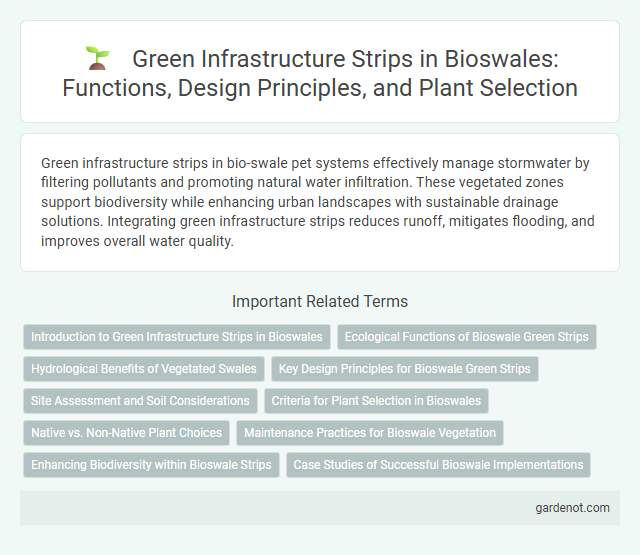Green infrastructure strips in bio-swale pet systems effectively manage stormwater by filtering pollutants and promoting natural water infiltration. These vegetated zones support biodiversity while enhancing urban landscapes with sustainable drainage solutions. Integrating green infrastructure strips reduces runoff, mitigates flooding, and improves overall water quality.
Introduction to Green Infrastructure Strips in Bioswales
Green infrastructure strips in bioswales serve as vegetated, engineered channels designed to manage stormwater runoff by filtering pollutants and promoting groundwater recharge. These strips utilize native plants, soil layers, and permeable substrates to slow water flow, enhance infiltration, and support biodiversity within urban landscapes. Design elements such as graded slopes, mulch layers, and appropriate plant selection optimize the bioswale's capacity to improve water quality and reduce flood risk.
Ecological Functions of Bioswale Green Strips
Bioswale green infrastructure strips enhance urban ecological functions by filtering pollutants from stormwater through vegetation and engineered soils, promoting groundwater recharge and reducing surface runoff. These strips support biodiversity by providing habitat for native plants and beneficial insects, while improving air quality and mitigating urban heat island effects. Their design optimizes water flow control, contributing to resilient, sustainable urban ecosystems.
Hydrological Benefits of Vegetated Swales
Vegetated swales serve as a key green infrastructure strip that significantly enhances urban hydrological management by promoting natural infiltration and reducing surface runoff volumes. These bio-swales improve groundwater recharge, filter pollutants, and mitigate stormwater peak flows through dense vegetation and engineered soil media. Implementing bio-swales effectively reduces flooding risks while improving water quality in urban watershed systems.
Key Design Principles for Bioswale Green Strips
Bioswale green strips utilize permeable soil media, native vegetation, and gentle slope gradients to optimize stormwater infiltration and pollutant removal. Key design principles emphasize maximizing hydraulic retention time, ensuring proper sizing based on watershed area, and incorporating overflow outlets for excess runoff management. Integrating these elements enhances water quality, reduces urban flooding risks, and supports sustainable landscape architecture.
Site Assessment and Soil Considerations
Site assessment for bio-swale implementation involves evaluating topography, hydrology, and existing vegetation to optimize water flow and pollutant filtration within the green infrastructure strip. Soil considerations prioritize well-draining, loamy soils with adequate organic matter content and permeability to support plant growth and enhance infiltration capacity. Proper soil testing for compaction, nutrient levels, and pH ensures long-term functionality and resilience of the bio-swale system.
Criteria for Plant Selection in Bioswales
Plant selection criteria in bioswales prioritize species with high tolerance to fluctuating moisture levels and the ability to absorb and filter pollutants from stormwater runoff. Deep-rooted, native plants are preferred to enhance soil stability and promote infiltration, while drought-resistant traits ensure plant survival during dry periods. Biodiverse plantings also support ecosystem health by attracting pollinators and improving habitat quality within urban green infrastructure strips.
Native vs. Non-Native Plant Choices
Choosing native plants for green infrastructure strips in bio-swales enhances stormwater absorption and supports local biodiversity more effectively than non-native species. Native vegetation typically requires less maintenance and irrigation, adapting well to regional soil and climate conditions. Non-native plants may outcompete native flora, reducing ecological benefits and potentially increasing management costs.
Maintenance Practices for Bioswale Vegetation
Effective maintenance of bioswale vegetation involves regular inspection to remove invasive species, ensuring native plants remain healthy and functional. Proper irrigation and mulching techniques promote plant growth, reduce erosion, and enhance pollutant filtration. Routine pruning and debris removal maintain water flow and optimize the bioswale's capacity to manage stormwater runoff.
Enhancing Biodiversity within Bioswale Strips
Bioswale strips act as vital green infrastructure, promoting biodiversity by providing habitat diversity and supporting native plant species. These strips filter stormwater while creating ecological corridors that enhance wildlife movement and pollinator populations. Integrating varied vegetation in bioswales improves soil health, water quality, and ecosystem resilience within urban landscapes.
Case Studies of Successful Bioswale Implementations
Case studies of successful bioswale implementations showcase significant improvements in urban stormwater management and water quality enhancement. Projects in Seattle and Portland demonstrate that integrating bioswales within green infrastructure strips effectively reduces runoff volume by up to 40% and filters pollutants such as heavy metals and sediments. These examples emphasize the bioswale's role in sustainable urban planning by promoting groundwater recharge and biodiversity in densely developed areas.
Green infrastructure strip Infographic

 gardenot.com
gardenot.com